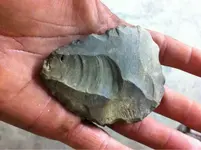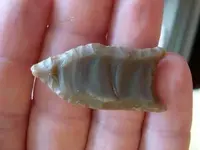You are using an out of date browser. It may not display this or other websites correctly.
You should upgrade or use an alternative browser.
You should upgrade or use an alternative browser.
Fluting success
- Thread starter painterx7
- Start date
GatorBoy
Gold Member
- Joined
- May 28, 2012
- Messages
- 14,716
- Reaction score
- 6,156
- Golden Thread
- 0
- Primary Interest:
- All Treasure Hunting
Yes that is what I'm thinking.
I'm No expert knapper or anything but that is a flake with a little work on the side.
I don't really want to try to explain the whole process but platforms that are created by percussion flaking a biface are necessary in order to pressure flake anything more than just an edge.
There is no channel on that piece only a flat spot and I'm guessing the other side is completely flat.
There is a process to creating a well-made projectile point and that piece just does not fit into those steps.
A simple triangle may be able to be made from that... or a flake blade which looks like was already done
I'm No expert knapper or anything but that is a flake with a little work on the side.
I don't really want to try to explain the whole process but platforms that are created by percussion flaking a biface are necessary in order to pressure flake anything more than just an edge.
There is no channel on that piece only a flat spot and I'm guessing the other side is completely flat.
There is a process to creating a well-made projectile point and that piece just does not fit into those steps.
A simple triangle may be able to be made from that... or a flake blade which looks like was already done
Last edited:
rock
Gold Member
Are you thinking that they wouldn't of made a point out of this piece with a little pressure flaking
I call that a flake tool. I have some but they are smaller. Maybe these are fluted pieces I found last week IDK but they look like it. Broken, the 2 on the bottom.
Attachments
- Joined
- Jan 27, 2009
- Messages
- 18,871
- Reaction score
- 12,120
- Golden Thread
- 1
- Location
- South East Tennessee on Ga, Ala line
- 🥇 Banner finds
- 1
- Detector(s) used
- Tesoro Conquistador freq shift
Fisher F75
Garrett AT-Pro
Garet carrot
Neodymium magnets
5' Probe
- Primary Interest:
- All Treasure Hunting
NC field hunter
Silver Member
Check out the thought process in this authentic cumberland from Tn river
<img src="http://www.treasurenet.com/forums/attachment.php?attachmentid=873650"/>
Wowzers!!
Jon Stewart
Bronze Member
Normally fluting takes place after the point or blade is completed. I have a friend that is a master flintknapper and has run flutes the full length of points. NOTE: that it doesn't always happen. If you care to view his work check out Mike Cook (Art of Ishi) on flintknappers.com.
Similar threads
- Replies
- 4
- Views
- 498
- Replies
- 26
- Views
- 3K
- Replies
- 1
- Views
- 435
Users who are viewing this thread
Total: 1 (members: 0, guests: 1)







